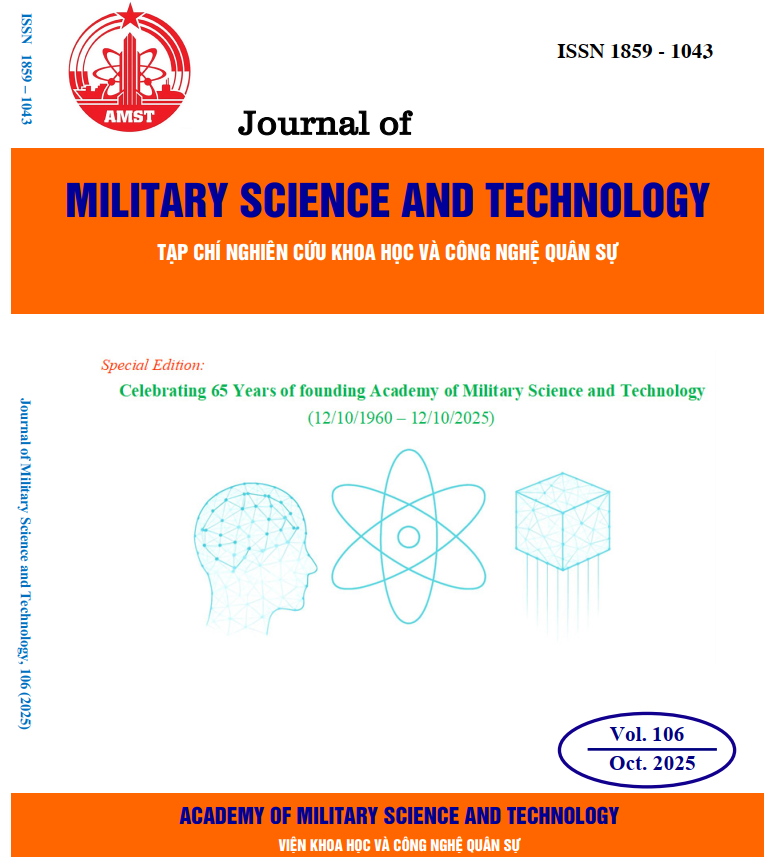Identification of process parameters in CDA-110 copper T-shaped tube hydroforming
242 viewsDOI:
https://doi.org/10.54939/1859-1043.j.mst.106.2025.145-153Keywords:
Tube hydroforming process; Process parameter identification; Multi-objective optimization; Surrogate model; Latin Hypercube Sampling; CDA-110 copper.Abstract
This study develops a systematic method to identify the optimal process parameters of a T-shaped tube hydroforming process. Three process parameters: (1) axial displacement, (2) pressure amplification, and (3) maximum inner pressure are examined to optimize two critical performance metrics: minimum wall thickness (STH) and branch height (Height). Finite element analyses were conducted in Abaqus/Explicit to characterize the input-output relationships. Multi-objective optimization based on the Pareto front approach is applied to identify optimal process parameters that trade-off between STH and Height. Numerical validation demonstrates the effectiveness of the presented method.
References
[1]. M. Ahmetoglu and T. Altan. "Tube Hydroforming: State-of-the-Art and Future Trends", J. Mater. Process. Technol., vol. 98, no. 1, pp. 25–33, (2000). DOI: https://doi.org/10.1016/S0924-0136(99)00302-7
[2]. S. Chinchanikar, H. Mulik, P. Varude, S. Atole, and N. Mundada. "A review of emerging hydroforming technologies: design considerations, parametric studies, and recent innovations", J. Eng. Appl. Sci., vol. 71, no. 1, p. 205, (2024). DOI: https://doi.org/10.1186/s44147-024-00546-z
[3]. K. I. Manabe and M. Amino. "Effects of process parameters and material properties on deformation process in tube hydroforming", J. Mater. Process. Technol., vol. 123, no. 2, pp. 285–291, (2002). DOI: https://doi.org/10.1016/S0924-0136(02)00094-8
[4]. K. Zheng, J.-H. Zheng, Z. He, G. Liu, D. J. Politis, and L. Wang. "Fundamentals, Processes and Equipment for Hot Medium Pressure Forming of Light Material Tubular Components", Int. J. Lightweight Mater. Manuf., vol. 3, no. 1, pp. 1–19, (2020). DOI: https://doi.org/10.1016/j.ijlmm.2019.10.003
[5]. Y. Xu, X. Zhang, W. Xie, S. Zhang, Y. Tian, and L. Chen. "Optimisation of Aluminium Alloy Variable Diameter Tubes Hydroforming Process Based on Machine Learning", Appl. Sci., vol. 15, no. 9, p. 5045, (2025). DOI: https://doi.org/10.3390/app15095045
[6]. N. V. Queipo, R. T. Haftka, W. Shyy, T. Goel, R. Vaidyanathan, and P. K. Tucker. "Surrogate-based analysis and optimization", Prog. Aerosp. Sci., vol. 41, no. 1, pp. 1–28, (2005). DOI: https://doi.org/10.1016/j.paerosci.2005.02.001
[7]. N. A. Pham, Q. T. Pham, V. D. Dinh, D. T. Nguyen, D.-T. Nguyen, T. D. Hoan, L. D. Giang. "Formability Assessment of C1100 Pure-Copper Tube Considering an Enhanced Modified Maximum Force Criterion", Materials, vol. 18, no. 9, p. 1919, (2025). DOI: https://doi.org/10.3390/ma18091919
[8]. M. T. Trinh, T. D. Nguyen, Q. T. Pham, A. N. Pham, D. V. Dinh. "Hydro-Forming of U-Shaped Parts with Branches", Engineering, Technology & Applied Science Research, vol. 15, no. 1, (2025). DOI: https://doi.org/10.48084/etasr.9227
[9]. M. T. Trinh, D. T. Nguyen, T. Q. Pham, A. N. Pham, V. D. Dinh. "Hydro-Forming a Cross-Shaped Component from Tube Billet", Journal of Machine Engineering, vol. 25, no. 2, pp. 111–122, (2025). DOI: https://doi.org/10.36897/jme/204661
[10]. D. C. Montgomery. Design and Analysis of Experiments, 10th ed., Hoboken, NJ, USA: Wiley, (2019).
[11]. K. Deb, A. Pratap, S. Agarwal, and T. Meyarivan. "A Fast and Elitist Multiobjective Genetic Algorithm: NSGA-II", IEEE Trans. Evol. Comput., vol. 6, no. 2, pp. 182–197, (2002). DOI: https://doi.org/10.1109/4235.996017
[12]. M. S. Chebbah and N. Lebaal. "Tube hydroforming optimization using a surrogate modeling approach and Genetic Algorithm", Mech. Adv. Mater. Struct., vol. 27, no. 6, pp. 515–524, (2018). DOI: https://doi.org/10.1080/15376494.2018.1482578
[13]. Z. Zhang, F. Xu, and X. Sun. "Optimization of process parameters during hydroforming of tank bottom using NSGA-III algorithm", Int. J. Adv. Manuf. Technol., vol. 119, pp. 4043–4055, (2022). DOI: https://doi.org/10.1007/s00170-021-08057-4
[14]. P. Saves, R. Lafage, N. Bartoli, Y. Diouane, J. H. Bussemaker, T. Lefebvre, J. T. Hwang, J. Morlier, and J. R. R. A. Martins. "SMT 2.0: A Surrogate Modeling Toolbox with a focus on Hierarchical and Mixed Variables Gaussian Processes", Advances in Engineering Software, (2024). DOI: https://doi.org/10.1016/j.advengsoft.2023.103571
[15]. T. Huang, X. Song, and M. Liu. "A Kriging-based non-probability interval optimization of loading path in T-shape tube hydroforming", Int. J. Adv. Manuf. Technol., vol. 85, no. 5, pp. 1615–1631, (2016). DOI: https://doi.org/10.1007/s00170-015-8034-x
[16]. B. Phipson, S. C. Lee, I. Majewski, W. Alexander, and G. Smyth. "Robust hyperparameter estimation protects against hypervariable genes and improves power to detect differential expression", Annals of Applied Statistics, vol. 10, no. 2, pp. 946–963, (2016). DOI: https://doi.org/10.1214/16-AOAS920
[17]. J. Blank and K. Deb. "pymoo: Multi-objective optimization in Python", IEEE Access, vol. 8, pp. 89497–89509, (2020). DOI: https://doi.org/10.1109/ACCESS.2020.2990567
[18]. W. Dan, X. Yue, M. Yu, T. Li, and J. Zhang. "Prediction and Global Sensitivity Analysis of Long-Term Deflections in Reinforced Concrete Flexural Structures Using Surrogate Models", Materials, vol. 16, no. 13, (2023). DOI: https://doi.org/10.3390/ma16134671
[19]. A. Saltelli, P. Annoni, I. Azzini, F. Campolongo, M. Ratto, and S. Tarantola. "Variance Based Sensitivity Analysis of Model Output. Design and Estimator for the Total Sensitivity Index", Comput. Phys. Commun., vol. 181, no. 2, pp. 259–270, (2010). DOI: https://doi.org/10.1016/j.cpc.2009.09.018







